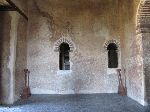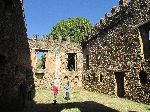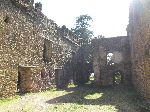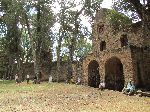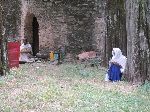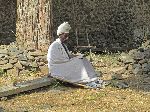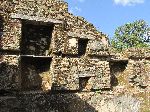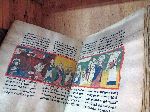| Ethiopia:
Abyssinia Adventure - Hwy 3 Bicycle Africa / Ibike Tours |
|||
 |
The character of Gondar prior to 1636 is unknown, but in that year Emperor Falisadas established Gondar as his national capital. For a little over a century it flourished and added to its Imperial infrastructure. It is this legacy that draws tourist to Gondar today. | ||
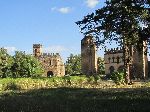 |
A walking tour of Gondar's historic sites provide a very good introduction to the history of imperial Gondar. We will start with a walk through Fasil Ghebbi, the Royal Enclosure, a walled enclave for the Head of State from around 1640 to about 1760. Across the road from the entrance is a magnificent, 400 year old tree (right) That makes it about 40 years older than Gondar, itself. Though old, the tree doesn't seem to have a sacred or ritual purpose. |
 |
|
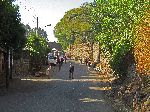 |

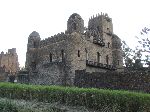
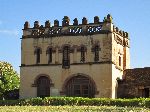
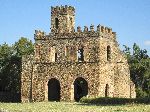
The stone wall surrounding Fasil Ghebbi is 900m (over a half mile) long and has a dozen gates. The interior has an open forest, lawns, gardens, a half dozen impressive buildings built by emperors of the Solomonic dynasty of Gondar in the 17th and 18th century and a similar number of buildings in ruins. |
 |
|
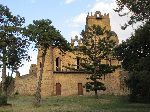 |
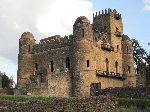
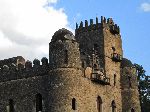
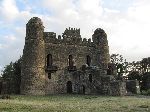
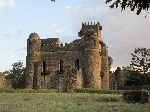
The oldest, most intact and most architecturally interesting of the buildings is the castle of
Emperor Fasilidas (reign 1632-1667), which was built around 1640. It has
design elements drawn from the Portuguese, Axumite, Indian, Ottoman, Romans,
Jewish cultures and elsewhere. Very thick wall helped to keep the building warm in the
winter, cool in the summer, and standing for almost 400 years -- including through
earthquakes. In many of the
rooms there are Stars of David in bas relief. The six pointed star became the emblem of the
Ethiopian royal family after the Solomonic dynasty reclaimed the throne in the
13th century. The Solomonic dynasty traces its lineage back to Solomon of
Judea. |
 |
|
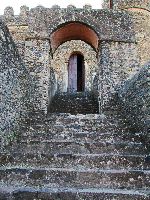 |

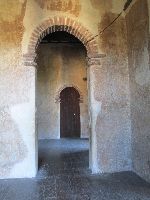
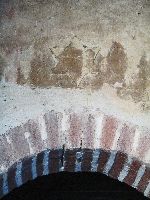
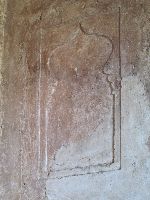 |
 |
|
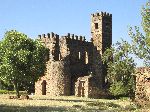 |
|||
|
|
Behind Emperor Fasilidas'
Castle is the royal cistern. It has a set of
stairs winding down the walls to facilitate fetching water, whatever the water
level. Fasiladas became Emperor in 1632 when his father, Emperor Susenyos,
abdicated. Once he became emperor his reign reflected a mixed world view compared
to the inclusive architecture of the Castle: Fasilides immediately restored the
official status of the traditional Ethiopian Orthodox Church, which had been
disestablished by his father in favor of Catholicism. On the one hand, he sent for a new abuna
(chief bishop of the Ethiopian Church)
from the Patriarch of Alexandria, restoring the ancient relationship that had
been allowed to lapse. And, on the other hand, he alienated others and isolated the
country: Fasilides started by confiscated the lands of the Jesuits. When
he heard that the Portuguese bombarded Mombasa (c. 1634, though it is not clear
why the Portuguese, who controlled Mombasa, would have bombed it at this time), he assumed that the Roman
Catholic prelate, Afonso Mendes, was behind the act, and banished the remaining
Jesuits from his lands. Mendes and most of his followers made their way back to
Goa, via Massawa, being robbed or imprisoned several times on the way. In 1665, he ordered
the "Books of the Franks"—the remaining religious writings of the
Catholics—burnt. |
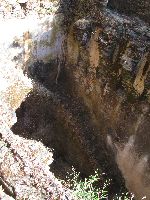 |
|
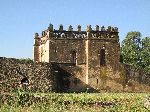 |
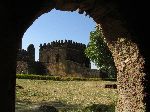 Emperor
Fasiladas was succeeded to the throne by his forth son, Emperor Yohannes I
(reign 1667-1682). Emperor Yohannes I's contribution to the Fasil Ghabbi,
is a library, located midway between Yasiladas' Palace and the Archive. Yohannes I spent much of his
reign campaigning against rebellions and suppressing attempts by missionaries to
convert people to Catholicism. Emperor
Fasiladas was succeeded to the throne by his forth son, Emperor Yohannes I
(reign 1667-1682). Emperor Yohannes I's contribution to the Fasil Ghabbi,
is a library, located midway between Yasiladas' Palace and the Archive. Yohannes I spent much of his
reign campaigning against rebellions and suppressing attempts by missionaries to
convert people to Catholicism. |
 |
|
 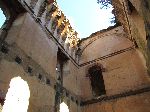 |
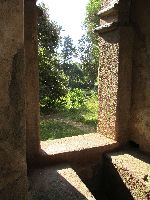 Adjacent
to Fasiladas Castle is Emperor Adiam Seghed Iyasu's Castle (reign 1682-1706).
Iyasu the Great was the son of Yohannas I and grandson of Fasiladas. The third
palace built at Fasil Ghabbi, Iyasu's was the most ornate. Guides and
guide books describe the palace as being spectacularly decorated with gilded Venetian mirrors and chairs,
gold leaf, ivory and beautiful paintings adorning the walls. Visiting travelers
of the time described the palace as "more beautiful than Solomon's house." Adjacent
to Fasiladas Castle is Emperor Adiam Seghed Iyasu's Castle (reign 1682-1706).
Iyasu the Great was the son of Yohannas I and grandson of Fasiladas. The third
palace built at Fasil Ghabbi, Iyasu's was the most ornate. Guides and
guide books describe the palace as being spectacularly decorated with gilded Venetian mirrors and chairs,
gold leaf, ivory and beautiful paintings adorning the walls. Visiting travelers
of the time described the palace as "more beautiful than Solomon's house."An earthquake in 1704 and British bombing of the Italian military command in the 1940s, have done away with the most of the lofty ceilings and the roof and anything of value was stripped from the premise long ago, but the building still shares a few secrets from its past: Iyasu's reign is noteworthy for the attention he devoted to administration, holding a large number of councils to settle theological and ecclesiastical matters (the first in 1684, in the public square of Gondar) matters of state, and to proclaim laws. He is considered the greatest emperor of the Gondar period. Early in his reign he improved the living conditions of the imprisoned princes who were traditionally kept in captivity on Amba Wahni. In 1698, Iyasu undertook a number of reforms, affecting customs and taxation, which encouraged trade. After Iyasu the Great's retirement, he was murdered by his son Tekla Haymanot (r. 1706-1708), likely with the support of his mother and Iyasu's wife, Empress Malakotawit, which led to a series of royal poisonings and assassinations (including Tekla Haymanot's), led to a period of instability and eventually a diminished role for Gondar. The next Emperors were Tewoflos I (r. 1708-1711)
(brother of Iyasu I, and one of four sons of Fasilides), and Yostos (r.
1711-1716) (son of Delba Iyasu and a daughter of Emperor Iyasu I). Neither left
an edifice at Fasil Ghabbi. |
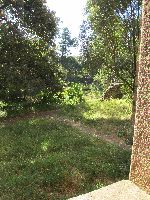 At the back of Iyasu's Castle there are two window seats (right) where a couple could set and talk and look out into the palace garden. |
|
|
|
Emperor Adbar-Seghed Dawit
III (Debal Ghinb)
(reigned 1716-1721), who was known for his patronage of Amharic folk songs.
Emperor Dawit was the son of Iyasu I and his concubine Kedeste Krestos. The
political situation was so unstable during his reign he stayed in Gondar most of
the time. Dawit's contribution in the Royal Enclosure is an entertainment/ performance hall (Dawit's Hall). Here many religious and secular ceremonies and parties were held, and the Emperor could hear minstrels perform, for which he was known as "Dawit the Singer". The building in now roofless, but its high walls and large windows hint at its historic grandeur. In matters of state, in 1721, Dawit presided over a synod of the Ethiopian Church, concerning a Christology disputed between the monks of the House of Ewostatewos in Gojjam and the monks of Debre Libanos. The Emperor sided with the Ewostathians. The monks of Debre Libanos then demonstrated against the results of the council, irritating Emperor Dawit to the point he sent a party of pagan Oromo from his Guard to slaughter them. Dawit fell ill shortly after this synod, and died under mysterious
circumstances. His courtiers and a Muslim apothecary were accused of poisoning
him and executed. |
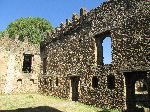 |
|
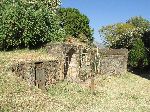 |
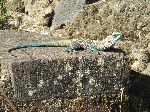 Dawit also had a fondness for lions so the first of two clusters of lion cages
were built. (The second was built by Haile Selassie.)
The last of the Abyssinian lions passed in 1992 and there don't seem to be any plans to
acquire replacements. This is for the best because the enclosures are
criminally small for any large cat. Dawit also had a fondness for lions so the first of two clusters of lion cages
were built. (The second was built by Haile Selassie.)
The last of the Abyssinian lions passed in 1992 and there don't seem to be any plans to
acquire replacements. This is for the best because the enclosures are
criminally small for any large cat.Of the current wildlife, I was able to get
a picture of a multi-color lizard and a white necked dove. |
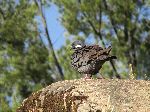 |
|
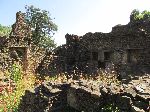 |
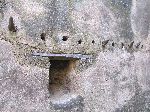 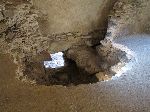 There
is a stand-alone building, largely in ruins, that was a "Turkish bath."
Heat for the bath/sauna was generated in a firebox that was accessed from the
outside and located partially under the floor. In the changing room a few cow-horn hooks
for hanging clothes still remain. There
is a stand-alone building, largely in ruins, that was a "Turkish bath."
Heat for the bath/sauna was generated in a firebox that was accessed from the
outside and located partially under the floor. In the changing room a few cow-horn hooks
for hanging clothes still remain. |
||
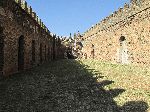 |
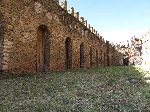 When Dawit came to a bad end (likely poisoned in 1721), the Emperor Bakaffa
(r. 1721-1730) took up the reins of power. He was a son of Emperor Iyasu I
and brother to Emperors Tekle Haymanot I and Dawit III. The period was
characterized by growing intrigue and conspiracies. Bakaffa responded with a
reign of terror. Bakaffa is also known for his intelligent, confident and beautiful
second wife, Mentewab (see below). His first wife died after the feast on
the night of her coronation. Bakaffa's contribution to the royal complex was
to build a huge banqueting hall and impressive stables -- enough to hold the
horses of all of his guests -- on the northern edge. Though from within
the building there is not much of a view, from outside there are impressive views
of the surrounding countryside. When Dawit came to a bad end (likely poisoned in 1721), the Emperor Bakaffa
(r. 1721-1730) took up the reins of power. He was a son of Emperor Iyasu I
and brother to Emperors Tekle Haymanot I and Dawit III. The period was
characterized by growing intrigue and conspiracies. Bakaffa responded with a
reign of terror. Bakaffa is also known for his intelligent, confident and beautiful
second wife, Mentewab (see below). His first wife died after the feast on
the night of her coronation. Bakaffa's contribution to the royal complex was
to build a huge banqueting hall and impressive stables -- enough to hold the
horses of all of his guests -- on the northern edge. Though from within
the building there is not much of a view, from outside there are impressive views
of the surrounding countryside. |
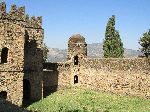 |
|
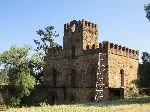 |
The northeast corner of the enclosure is
occupied by Birhan Seghed Kuregna Iyasu
II and Itegie Mentewab's Castle (r. 1730-1755).
It is the last palace to be built in the Royal Enclosure. Iyasu
II was the son of Emperor Bakaffa and Empress Mentewab. The Empress Mentewab played a major role in Iyasu's reign. Instead of taking the title of regent upon the succession of her
underage son, Empress Mentewab had herself crowned as co-ruler, becoming the
first woman to be crowned in this manner in Ethiopian history. Empress Mentewab
wielded significant authority throughout the reign of her son, and contended but
failed to retain the role into the
reign of her grandson, Emperor Iyoas (1755-1769), which lead to her retirement.
Despite Mentewab's intelligence and counsel, Iyasu II proved to be an ineffectual monarch. According to Paul Henze, Iyasu "came under criticism for devoting too much time to pleasure (he loved hunting) and for spending too many resources on embellishing the capital, paying foreign workmen, and importing luxury goods, ornaments and mirrors from Europe." This led to a growth of real power and wealth being held in the provinces and the decline of the significance of Gondar, especially after 1755. High on the intrigue scale, Emperor Iyasu II resented deeply the romantic liaison his mother entered into with a young member of the Imperial family. After the death of her husband Emperor Bakaffa, Empress Mentewab became involved with another Iyasu, the son of the sister of Bakaffa, Romanework, and on her father's side, Emperor Iyasu I, descended in the male line from another cadet line of the Solomonic dynasty. Mentewab's relationship with the much younger nephew of her late husband was considered a great scandal, and the young Prince was derisively referred to as "Melmal Iyasu", or "Iyasu the Kept". The Empress had three daughters by this Melmal Iyasu.. Emperor Iyasu II became very attached to his half-sisters, but was deeply resentful of their father. It is said that it was the Emperor himself that ordered the murder of his mother's lover by having him pushed from a cliff top near Lake Tana in 1742. One of Mentewab's daughters was the beautiful Woizero Aster Iyasu who took Ras Mikael Sehul, the Governor of Tigre and war lord, as her third husband, in 1769. Iyasu fell seriously ill in May, 1755, and died the next month. It was generally believed that he had been poisoned by the sister of Melmal Iyasu, in revenge for her brother's death. |
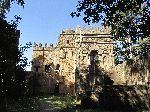 |
|
 |
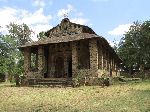
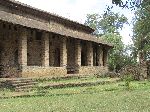

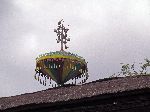 At least seven of the churches in Gondar date back to the period of the Fasilada's rule. A little newer is Debre Berhan Selassie church which was founded in 1690's by Iyasu I. It is believed that the original church was round, based on the ruminants of the foundation that extend beyond the current church. The construction date of the current building is not known but it is believed to have been in the late 18th century. Fortunately, due to the intervention of a swarm of bees, as the story goes, it is the one church of dozens in Gondar that wasn't destroyed by the attack of the Dervish or Mahdist, of Sudan, in 1888. If it is any indication of any of the other churches at the time, the cultural and religious destruction by the Mahdist was substantial. |
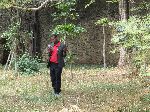 |
|
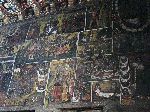 |

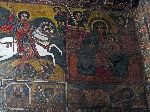
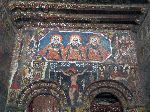
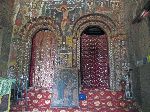 |
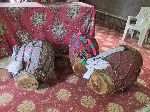 |
|
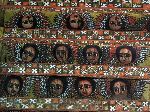 |
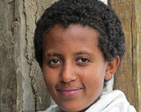 Architecturally
it is simple and elegant, but its real treasures are the floor to ceiling
paintings inside, and the ceiling in particular. The ceiling is covered
with 80 almost identical cherubs' faces. Coincidentally I saw a similar
featured child along the road a few days later. The subject of the walls is the
Life of Christ and other saints. Architecturally
it is simple and elegant, but its real treasures are the floor to ceiling
paintings inside, and the ceiling in particular. The ceiling is covered
with 80 almost identical cherubs' faces. Coincidentally I saw a similar
featured child along the road a few days later. The subject of the walls is the
Life of Christ and other saints. |
 |
|
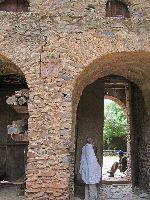 |
 The rules of the church are posted and read:
The rules of the church are posted and read:Allowed and Disallowed instructions in the Church. Flash light, chewing gum, wearing shoes or cape is forbidden * Only the first section of the Church is allowed to visit. * The West gate is reserved for men and the south-west for female. * If you have scarf, it is all advisable to put over your head for ladies. 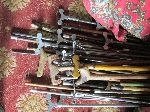 * As per the Church's rule you are advised not to go inside if you have slept with your spouse yesterday and during menstruation period for ladies. Thank you! The church has a supply of loaner staffs for those who come to pray (right). |
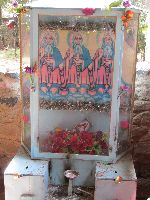 |
|
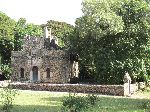 |
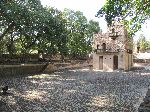 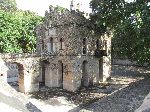 A
couple of kilometers west of Fasil Ghabbi is the royal pool. It too is behind a stone wall. The pool is
a long rectangular basin
built of stones. Near the west end of the pool is a
building built on high piers, connected to the side by a bridge. When the pool was
filled with water it would be surrounded. Perhaps this was to keep it cool
in the hot season, as was done by the Aghlabids in Tunisia. Along much of the wall trees have grown
up and dramatically draped
their roots down both sides of the wall. It's as if the trees are walking down
the top of the wall. Walking trees -- that is only suppose to be in fairy tales. A
couple of kilometers west of Fasil Ghabbi is the royal pool. It too is behind a stone wall. The pool is
a long rectangular basin
built of stones. Near the west end of the pool is a
building built on high piers, connected to the side by a bridge. When the pool was
filled with water it would be surrounded. Perhaps this was to keep it cool
in the hot season, as was done by the Aghlabids in Tunisia. Along much of the wall trees have grown
up and dramatically draped
their roots down both sides of the wall. It's as if the trees are walking down
the top of the wall. Walking trees -- that is only suppose to be in fairy tales. |
 |
|
 |
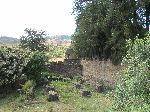 Another couple of
kilometers further west, on the top of a hill, with a picturesque view, is the
walled Kuskuam
(Qusquam) Church (named for a site in Egypt where the Holy Family had stayed
during their exile) and Palace
of Empress Mentewab. It was constructed in 1730, after the death of her
husband, Emperor Bakafa. It is not clear whether she spent more of her time at
Fasil Ghabbi or Qusquam for the next couple of decades. By some accounts Mentewab had so much power that the high affairs of government took place at
Qusquam. It is clearer that she lived out her life here after she exiled herself from
Gondar politics, in about 1755, as the city's power and influence waned.
She died in 1773. Another couple of
kilometers further west, on the top of a hill, with a picturesque view, is the
walled Kuskuam
(Qusquam) Church (named for a site in Egypt where the Holy Family had stayed
during their exile) and Palace
of Empress Mentewab. It was constructed in 1730, after the death of her
husband, Emperor Bakafa. It is not clear whether she spent more of her time at
Fasil Ghabbi or Qusquam for the next couple of decades. By some accounts Mentewab had so much power that the high affairs of government took place at
Qusquam. It is clearer that she lived out her life here after she exiled herself from
Gondar politics, in about 1755, as the city's power and influence waned.
She died in 1773. |
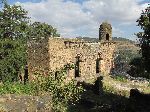 |
|
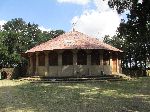 |
|
 |
|
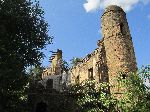 |
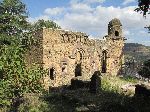 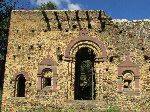 The
banquet hall is the most intact building on the site. The exterior window frames
are decorated with lions, and the building is topped by a Gonderine cross and
other icons. Isolated on the wall are reliefs of elephants and other
animals. The
banquet hall is the most intact building on the site. The exterior window frames
are decorated with lions, and the building is topped by a Gonderine cross and
other icons. Isolated on the wall are reliefs of elephants and other
animals. |
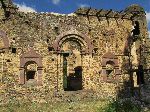 |
|
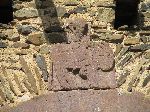
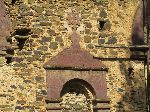
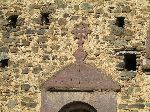
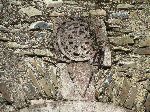 |
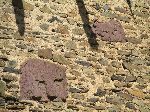 |
||
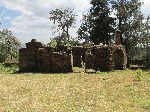 |
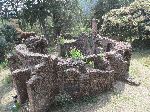 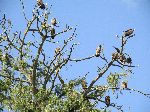 Most
of the buildings at Qusquam, including the Empress' residence and personal chapel
(with 12 alcoves) are in such bad repair it takes a scholar to read their story.
(left) Most
of the buildings at Qusquam, including the Empress' residence and personal chapel
(with 12 alcoves) are in such bad repair it takes a scholar to read their story.
(left)The trees at Qusquam are nice because besides providing shade, they host a variety of colorful birds. The most gregarious (and least colorful) specie in the barest trees, were the vultures, so they got the picture. |
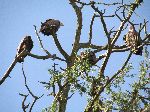 |
|
Now-a-days, much of the story of Qusquam is about James Bruce (14 December 1730 – 27 April 1794), a Scottish traveler, explorer and travel writer who spent more than a dozen years in North Africa and two years in Ethiopia, with the objective of tracing the origins of the Blue Nile.
When he arrived in Ethiopia, he was well received by reigning Emperor Tekle Haymanot II (r. 1769-1777), by Ras Mikael Sehul, the
power behind the throne until 1771, by Wozoro Aster, wife of the Ras (whom Bruce calls
"Esther"), and by the Ethiopians people generally. His stature (he was 6-foot
4 inches tall), his knowledge of Ge'ez (the language), his excellence
in sports, his courage and self-esteem, all worked in his favor among a people
who were generally distrustful of all foreigners. As he waited in Gondar for
permission to pursue his exploration of the headwaters of the Blue Nile, he
gained knowledge that enabled him to write extensively on Ethiopian life. |
|||
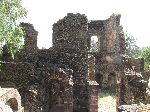
|
During the same period, in early and late 1769, Emperor Iyaos' strangulation, and his successor, Emperor Yohannes II poisoning, Mentewab's son and grandson, respectively, were ordered by Ras Mikael Sehul, Governor of Tigray, a war lord and future son-in-law of Mentewab.) |
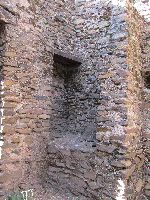 |
|
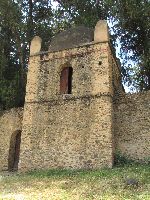 |
|
||
|
|
|||
|
|
Unique Programs To Special Places For Memories Of A Lifetime!
"Hosted by
DreamHost - earth friendly web hosting"
|
|

